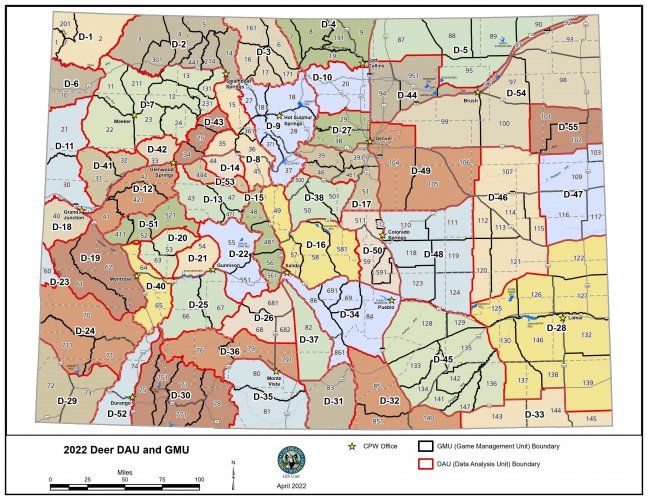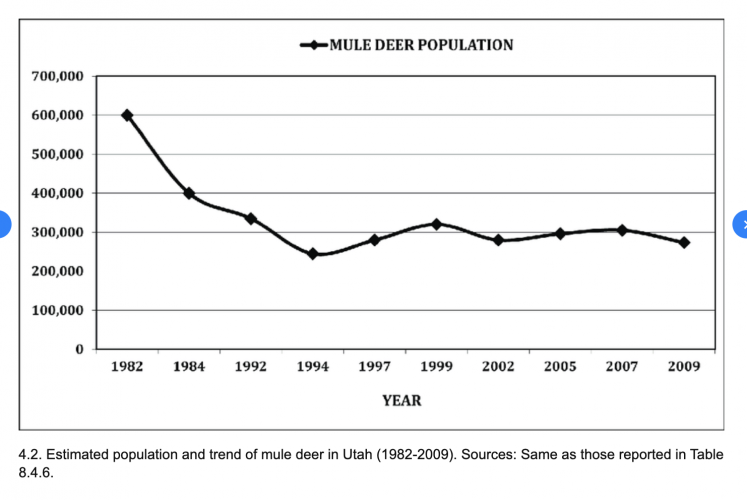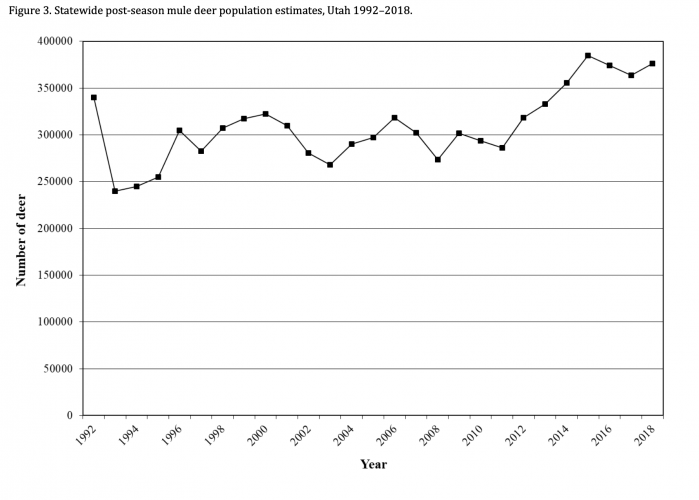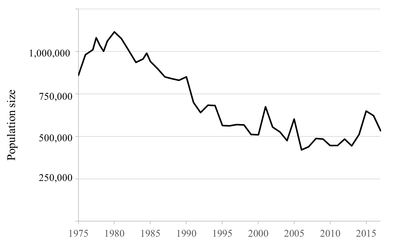Navigation
Install the app
How to install the app on iOS
Follow along with the video below to see how to install our site as a web app on your home screen.
Note: This feature may not be available in some browsers.
More options
You are using an out of date browser. It may not display this or other websites correctly.
You should upgrade or use an alternative browser.
You should upgrade or use an alternative browser.
Mule Deer Population trends
- Thread starter Irrelevant
- Start date
My buddy Jim Heffelfinger who oversees the AFWA working group says their data shows the populations of the 1950s and 60s was not sustainable. Maybe the same can be said of what we saw in the 1980s, though the numbers are much lower than the 50s and 60s.
And maybe, I hope not, we are at the levels of sustainability for the long-term. I think most hunters would be willing to try new management strategies and habitat improvements to see if increases can be achieved.
And maybe, I hope not, we are at the levels of sustainability for the long-term. I think most hunters would be willing to try new management strategies and habitat improvements to see if increases can be achieved.
MarvB
Well-known member
What’s really interesting to me with that is Cali ended a decade long drought right about 77-78 and THEN the numbers seemed to plummet…odd!
CycleFishHunt
Well-known member
Please forgive what may be unproductive questions, but to what extent, especially on 30-40 year time scales, might changes in estimation techniques distort the numbers?
As someone who is (trying to be less) ignorant of how these estimates are done, my assumption is that estimation techniques probably (hopefully) improve over time. Did we over or under estimate in the past? So is the decline better or worse than what we perceive?
Also, how relevant is the estimated decline over 40 years? There’s obvious scientific benefit to understanding it, but maybe not a practical management benefit. Meaning, if the management goal is X and today’s estimate is 70% or 110% of the goal, isn’t that what matters?
Hypothetically if we were at 500% 40 years ago it’s sort of irrelevant since the target is no where near that.
I hope this makes sense.
As someone who is (trying to be less) ignorant of how these estimates are done, my assumption is that estimation techniques probably (hopefully) improve over time. Did we over or under estimate in the past? So is the decline better or worse than what we perceive?
Also, how relevant is the estimated decline over 40 years? There’s obvious scientific benefit to understanding it, but maybe not a practical management benefit. Meaning, if the management goal is X and today’s estimate is 70% or 110% of the goal, isn’t that what matters?
Hypothetically if we were at 500% 40 years ago it’s sort of irrelevant since the target is no where near that.
I hope this makes sense.
I question the relevance of a state wide population trend. In Montana you could have western units with mule deer practically going extinct and state wide population growing. Which I believe to be the case.
In my opinion this provides cover for failed management in the western units and I would expect business as usual going forward.
In my opinion this provides cover for failed management in the western units and I would expect business as usual going forward.
antlerradar
Well-known member
Doing what needs to be done in the west is going to finish off the east. You are right, business as usual.I question the relevance of a state wide population trend. In Montana you could have western units with mule deer practically going extinct and state wide population growing. Which I believe to be the case.
In my opinion this provides cover for failed management in the western units and I would expect business as usual going forward.
Nameless Range
Well-known member
I question the relevance of a state wide population trend. In Montana you could have western units with mule deer practically going extinct and state wide population growing. Which I believe to be the case.
In my opinion this provides cover for failed management in the western units and I would expect business as usual going forward.
I don’t want To stray too much from what is a very interesting thread topic, but I believe this is spot on and is somewhat mirrored by the elk discussion when we look at raw numbers.
It is the distribution of animals on the landscape that matters - both to the people and the land - as much as anything.
I know chunks of Southwest Montana where I used to see significant mule deer populations 20 years ago. Maybe those days were the aberration, but it’s hard not to believe we are now living in the inverse for those geographies. Absolutely beautiful country and prime habitat essentially void of game.
antlerradar
Well-known member
I would also like to think that we could get back to the populations of the 80's and early 90's, but maybe those populations are not possible with the addition of the elk population. Even with the elk SE Montana has room for more mule deer than we currently have. In the spring when I am looking for antlers on the winter range, I find winterfat up to my knees and rabbit brush that is chest high and hardly browsed.My buddy Jim Heffelfinger who oversees the AFWA working group says their data shows the populations of the 1950s and 60s was not sustainable. Maybe the same can be said of what we saw in the 1980s, though the numbers are much lower than the 50s and 60s.
And maybe, I hope not, we are at the levels of sustainability for the long-term. I think most hunters would be willing to try new management strategies and habitat improvements to see if increases can be achieved.
I would hope that most hunters would be willing to try new management. You can not hunt today's populations like you did in the 1970's plus thousands of doe tags and expect a positive outcome.
Last edited:
I started hunting mule deer with my dad around 1970. To say that populations of the 50s and 60s are unattainable has merit. There were pretty big areas of good habitat with few to no elk. Few predators, and even few raptors.
The 80s had more mule deer in the areas that I hunt than any other time in my life and there were getting to be a lot of elk around. Predators weren't what they are now but they were around. I wouldn't consider that unattainable in at least some areas of west Mt.
To call mule deer populations of the 90s to 2000s unrealistic is just giving up in my opinion.
The 80s had more mule deer in the areas that I hunt than any other time in my life and there were getting to be a lot of elk around. Predators weren't what they are now but they were around. I wouldn't consider that unattainable in at least some areas of west Mt.
To call mule deer populations of the 90s to 2000s unrealistic is just giving up in my opinion.
Just an old guys observations and which concur with what BF has brought in with graphs, mule deer have been in decline for a long time. I also heard this from V. Geist in the 80's.
There where lots of mule deer across the west when I was young. Lots of blacktails along the coast.
Were I live in NM was the best mule deer spot in the country quality wise, IMHO. Very few deer now.
The decline has been all over the west, overall.
I have seen a slight increase in numbers in my unit, where the tags FINALLY got cut in half.
Elk numbers have increased. I cannot complain about that much but they do impact the deer feed.
NMG&F has done a decent job biology wise in a few areas. Elk. Desert Bighorns.
They get a D from me on deer. But they look like they are using some science these days.
There where lots of mule deer across the west when I was young. Lots of blacktails along the coast.
Were I live in NM was the best mule deer spot in the country quality wise, IMHO. Very few deer now.
The decline has been all over the west, overall.
I have seen a slight increase in numbers in my unit, where the tags FINALLY got cut in half.
Elk numbers have increased. I cannot complain about that much but they do impact the deer feed.
NMG&F has done a decent job biology wise in a few areas. Elk. Desert Bighorns.
They get a D from me on deer. But they look like they are using some science these days.
Irrelevant
Well-known member
I guess the point of the thread is I already knew what most of you would say. But when our wildlife biologists say otherwise we either,
1. Currently have a skewed perspective of reality and are not able to see that there are similar aggregate populations
2. Have a classic shifting baseline issue, and our own biologists are under playing the current cause for alarm
I think it's the second. From the minute I heard Mr. Heffelfinger talk about "stable" mule deer populations.
1. Currently have a skewed perspective of reality and are not able to see that there are similar aggregate populations
2. Have a classic shifting baseline issue, and our own biologists are under playing the current cause for alarm
I think it's the second. From the minute I heard Mr. Heffelfinger talk about "stable" mule deer populations.
One of the big pushes I have seen is to keep overall deer numbers and especially buck numbers low because of spreading cwd. That’s why I was curious about Sask/Alberta. You could have a lot of support to change management and I think the biologists would just say that’s not what the “science” is telling us to do.
Stand by for Colorado-related rambling for no real point....
You're not going to fix the "problem" without a plan or a desire to do so.
Colorado deer statewide long-term population objectives (AKA Shifting Baseline):
2007: 614,020
2021: 484,100
Difference: -129,920
What does this mean? It means our population goal has been reduced by over 21% in 14 years.
Colorado manages big game, including mule deer, by Data Analysis Unit (DAU). Here is a deer DAU map:

Each DAU is supposed to have a Herd Management Plan (HMP). HMPs are meant to be updated every 10 years, but there is a staff capacity issue in CPW that precludes this. Some plans are very old (D-3, 2002), and some DAU don't even have a plan (D-19)!
I have attached a 4-page document I clipped from a recent HMP that explains the HMP development process in detail. I will highlight this summary from that document (emphasis mine):
To summarize, an HMP sets population and sex ratio goals and prescribes harvest management actions to achieve them.
In general, HMPs a very good at identifying the issues influencing population dynamics at the DAU level. What they are not good at as currently written is developing strategies to address declining populations. If I were to summarize the typical HMP it would look something like this:
Here are some recent examples of shifting baselines:
D-7 White River Herd HMP, 2020
Previous objective: 67,500
New objective: 25,000-35,000
Issues:
D-8 State Bridge Herd HMP, 2020
Previous objective: 13,500-16,500
New objective: 10,000-14,000
(see this post about how this objective has steadily declined from 26,000 in the 1980s)
Issues:
D-14 Brush Creek Herd HMP, 2020
Previous objective: 7,000
New objective: 1,500-3,500
Issues:
D-20 North Fork Gunnison River Herd HMP, 2018
Previous objective: 12,500-14,500
New objective: 7,500-9,500
Issues:
Previous objective: 13,500-15,000
New objective: 6,500-8,500
Issues:
D-11 Bookcliffs Herd HMP, 2022
Previous objective: 10,000-12,000
New objective: 5,000-8,000
Issues:
D-42 Rifle Creek Herd HMP, 2022
Previous objective: 7,700-9,400
New objective: 6,200-8,200
Issues:
I could go on and on. But the point is that we will NEVER recover deer herds if we don't make a plan to reverse the trends of issues affecting those herds and set goals to recover those populations. The current strategy is to throw up our hands and adjust (reduce) harvest. This will take hunters actually caring and being willing to engage the issue 100%.
At the current rate of decline, what will populations look like in 20 years?
You're not going to fix the "problem" without a plan or a desire to do so.
Colorado deer statewide long-term population objectives (AKA Shifting Baseline):
2007: 614,020
2021: 484,100
Difference: -129,920
What does this mean? It means our population goal has been reduced by over 21% in 14 years.
Colorado manages big game, including mule deer, by Data Analysis Unit (DAU). Here is a deer DAU map:

Each DAU is supposed to have a Herd Management Plan (HMP). HMPs are meant to be updated every 10 years, but there is a staff capacity issue in CPW that precludes this. Some plans are very old (D-3, 2002), and some DAU don't even have a plan (D-19)!
I have attached a 4-page document I clipped from a recent HMP that explains the HMP development process in detail. I will highlight this summary from that document (emphasis mine):
"The primary decisions needed for an individual DAU plan are how many animals should exist in the DAU and what is the desired sex ratio for that population of big game animals e.g., the number of males per 100 females. These numbers are referred to as the DAU population and herd composition objectives, respectively. Secondarily, the strategies and techniques needed to reach the population size and herd composition objectives also need to be selected. The selection of population and sex ratio objectives drive important decisions in the big game season setting process, namely, how many animals need to be harvested to maintain or move toward the objectives, and what types of hunting seasons are required to achieve the harvest objective."
To summarize, an HMP sets population and sex ratio goals and prescribes harvest management actions to achieve them.
In general, HMPs a very good at identifying the issues influencing population dynamics at the DAU level. What they are not good at as currently written is developing strategies to address declining populations. If I were to summarize the typical HMP it would look something like this:
- Our previous population objective was X.
- Ten years later, our population is X - Y.
- The reasons for this decline include A, B, C, D, and E.
- Due to reasons A, B, C, D, and E, our new population objective will be X - Y.
Here are some recent examples of shifting baselines:
D-7 White River Herd HMP, 2020
Previous objective: 67,500
New objective: 25,000-35,000
Issues:
- "...the cumulative effects weather (drought and severe winters), habitat conditions, and disease (specifically, CWD) all appear to be contributing to the declining population trend in the D-7 herd."
- "The direct and indirect impacts of fragmentation from energy development (oil and gas, solar, etc.), trail development for recreation, and rural residential development reduces habitat function. Drought in combination with overuse by livestock, wild horses, and wildlife effects habitat quality. Fire suppression has increased canopy cover reducing winter range quality and in other areas, wildfire has resulted in significant losses of browse on critical winter range and increased competition from invasive annual grasses. Compounding the impacts of wildfire has been increased elk competition on winter ranges."
D-8 State Bridge Herd HMP, 2020
Previous objective: 13,500-16,500
New objective: 10,000-14,000
(see this post about how this objective has steadily declined from 26,000 in the 1980s)
Issues:
- "...the cumulative impacts of decades of human population growth and the direct and indirect impacts of human activities have continued to diminish both the quality and quantity of habitat and its carrying capacity for deer. Land development, fragmentation by roads and trails, increased human activity on public lands, and suppression of large-scale wildfires have long-term and perhaps even irreversible effects on the landscape. The proliferation of all forms of outdoor recreation on public lands has continued since the 2009 herd management plan."
D-14 Brush Creek Herd HMP, 2020
Previous objective: 7,000
New objective: 1,500-3,500
Issues:
- "The major issues for this deer herd involve the cumulative effects of decades of human population growth and impacts of human activities on deer habitat in the Eagle River Valley. The result has been a loss of habitat quantity and quality and less solitude from human disturbance."
- "Significant issues include habitat loss and fragmentation from land development, declining habitat condition, and impacts of human recreation on deer."
D-20 North Fork Gunnison River Herd HMP, 2018
Previous objective: 12,500-14,500
New objective: 7,500-9,500
Issues:
- "Habitat, especially in deer winter range, has been reduced in amount and quality due to human development and associated infrastructure. Diseases like Epizootic Hemorrhagic Disease Virus, which has been documented in the North Fork Gunnison River deer herd, may also play a role in suppressing this population’s growth."
Previous objective: 13,500-15,000
New objective: 6,500-8,500
Issues:
- "Suitable winter range habitat has diminished due to land conversions and human development. Additionally, outdoor recreation has increased dramatically over the last decade and can have many impacts including loss of effective habitat, changes in seasonal migration patterns, and potentially lower survival rates. Overgrazing by domestic livestock and persistent drought have decreased the quality of habitat across the landscape as well."
D-11 Bookcliffs Herd HMP, 2022
Previous objective: 10,000-12,000
New objective: 5,000-8,000
Issues:
- "...declining fawn:doe ratios, population stagnation, recreation, energy development, disease, and degraded habitats due to feral horses, long-term drought, over-utilization, and wildfire."
D-42 Rifle Creek Herd HMP, 2022
Previous objective: 7,700-9,400
New objective: 6,200-8,200
Issues:
- "...disease, degraded habitats due to drought and over-utilization, recreational disturbance, residential development, long-term low fawn:doe ratios, and population stagnation. The habitat is fragmented and degraded throughout much of the herd’s important ranges. Increases in residential development and recreational activities in the area leaves few areas free from human disturbance."
I could go on and on. But the point is that we will NEVER recover deer herds if we don't make a plan to reverse the trends of issues affecting those herds and set goals to recover those populations. The current strategy is to throw up our hands and adjust (reduce) harvest. This will take hunters actually caring and being willing to engage the issue 100%.
At the current rate of decline, what will populations look like in 20 years?
Attachments
SaskHunter
Well-known member
I don't disagree, nor does that status report
View attachment 227424
I do believe Jim has been quoted as saying some of the historically high populations we've seen were simply not sustainable levels. Now if my memory serves me right, and it almost never does, he was specifically referring to the 1950s as artificially high populations.
Based on that status report, mule deer seem to be increasing at the two extremes of their range, both the Texas panhandle and Alberta/Sask are seeing increases.
The mule deer pop in Saskatchewan is doing very well and they keep pushing farter North. You can find them anywhere in the lower half of the Province which constitutes farmland.
They seem to keep doing well, even with some of the recent harsh weather we've had in recent years; drought, extreme low temps and heavy snow winters.
The one thing we're doing right is management. Our mule deer harvest is archery OTC or draw with very limited quotas only. It is also reserved to residents only. Saskatchewan doesn't have the same hatred for its wildlife that Montana seems to have. The management is for the most part, done well and in favour of wildlife, not the Province'a coffers. For example, the decline of our farmland moose pop is being addressed, no more harvest of cows, bulls only, with reduced quotas.
They next big thing for our mule deer is definitely CWD. It's not looking good on that front and given that it is a "slow killing" illness we still don't know what the future will look like. There was hinting at addressing buck quotas as they are disproportionally affected due to theit rutting behaviours and tendency to shove their faces up every does' behind.
Crazy what difference that length of cattle fence along the Saskatchewan/Montana border, does to herd management.
Hasn’t cwd been in Canada for a long time?The mule deer pop in Saskatchewan is doing very well and they keep pushing farter North. You can find them anywhere in the lower half of the Province which constitutes farmland.
They seem to keep doing well, even with some of the recent harsh weather we've had in recent years; drought, extreme low temps and heavy snow winters.
The one thing we're doing right is management. Our mule deer harvest is archery OTC or draw with very limited quotas only. It is also reserved to residents only. Saskatchewan doesn't have the same hatred for its wildlife that Montana seems to have. The management is for the most part, done well and in favour of wildlife, not the Province'a coffers. For example, the decline of our farmland moose pop is being addressed, no more harvest of cows, bulls only, with reduced quotas.
They next big thing for our mule deer is definitely CWD. It's not looking good on that front and given that it is a "slow killing" illness we still don't know what the future will look like. There was hinting at addressing buck quotas as they are disproportionally affected due to theit rutting behaviours and tendency to shove their faces up every does' behind.
Crazy what difference that length of cattle fence along the Saskatchewan/Montana border, does to herd management.
SaskHunter
Well-known member
Hasn’t cwd been in Canada for a long time?
It has. It was allegedly brought in from the US in infected elk in the 80s but it wasn't until early 2000s that it was found in wild animals.
CWD is exponential. It starts slow but over time gets worst. Some of our zones have a 70% infection rate in bucks as of last season.
S-3 Ranch
Well-known member
This is going to sound strange or funny to some .
but when we had some large areas mismanaged, we shut the hunting off completely for 5 years, it was easier to comeback and clean up the units then fight a uphill battle with poor hunter harvest
maybe shutting down mule deer and increase elk harvest would be beneficial??
but when we had some large areas mismanaged, we shut the hunting off completely for 5 years, it was easier to comeback and clean up the units then fight a uphill battle with poor hunter harvest
maybe shutting down mule deer and increase elk harvest would be beneficial??
Similar threads
- Replies
- 4
- Views
- 696







